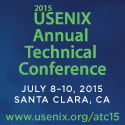Technical Sessions
The full Proceedings published by USENIX for the conference are available for download below. Individual papers can also be downloaded from the presentation page. Copyright to the individual works is retained by the author[s].
Proceedings Front Matter
Proceedings Cover | Title Page and List of Organizers | Table of Contents | Message from the Program Co-Chairs
Full Proceedings PDFs
![]() USENIX ATC '15 Full Proceedings (PDF)
USENIX ATC '15 Full Proceedings (PDF)
![]() USENIX ATC '15 Proceedings Interior (PDF, best for mobile devices)
USENIX ATC '15 Proceedings Interior (PDF, best for mobile devices)
![]() USENIX ATC '15 Errata Slip (PDF) (Updated 6/29/15)
USENIX ATC '15 Errata Slip (PDF) (Updated 6/29/15)
![]() USENIX ATC '15 Errata Slip (PDF) (Updated 7/9/15)
USENIX ATC '15 Errata Slip (PDF) (Updated 7/9/15)
![]() USENIX ATC '15 Errata Slip (PDF) (Updated 12/23/15)
USENIX ATC '15 Errata Slip (PDF) (Updated 12/23/15)
Full Proceedings ePub (for iPad and most eReaders)
![]() USENIX ATC '15 Full Proceedings (ePub)
USENIX ATC '15 Full Proceedings (ePub)
Full Proceedings Mobi (for Kindle)
![]() USENIX ATC '15 Full Proceedings (Mobi)
USENIX ATC '15 Full Proceedings (Mobi)
Downloads for Registered Conference Attendees
(Registered attendees: Sign in to your USENIX account to download these files.)

 USENIX ATC '15 Attendee List
USENIX ATC '15 Attendee List
Wednesday, July 8, 2015
| 7:30 am–8:30 am | Wednesday |
Continental Breakfast |
|
| 8:30 am–8:45 am | Wednesday |
| 8:45 am–9:50 am | Wednesday |
| 9:50 am–10:15 am | Wednesday |
Break with Refreshments |
|
| 10:15 am–11:55 am | Wednesday |
| 11:55 am–1:25 pm | Wednesday |
Lunch (on your own) |
|
| 1:25 pm–3:30 pm | Wednesday |
|
|
|
| 3:30 pm–3:55 pm | Wednesday |
Break with Refreshments |
|
| 3:55 pm–6:00 pm | Wednesday |
|
|
|
| 6:30 pm–8:30 pm | Wednesday |
Conference ReceptionMingle with fellow attendees in the Terra Courtyard for the Conference Reception. Enjoy dinner, drinks, and the summer evening by the pool. |
|
Thursday, July 9, 2015
| 7:30 am–8:30 am | Thursday |
Continental Breakfast |
|
| 8:30 am–10:35 am | Thursday |
| 10:35 am–11:00 am | Thursday |
Break with Refreshments |
|
| 11:00 am–12:40 pm | Thursday |
|
|
|
| 12:40 pm–2:10 pm | Thursday |
Conference Luncheon |
|
| 2:10 pm–3:50 pm | Thursday |
|
|
|
| 3:50 pm–4:15 pm | Thursday |
Break with Refreshments |
|
| 4:15 pm–5:05 pm | Thursday |
|
|
|
| 5:05 pm–6:00 pm | Thursday |
|
|
|
| 6:30 pm–8:00 pm | Thursday |
|
|
|



























connect with us